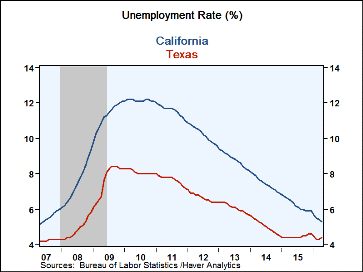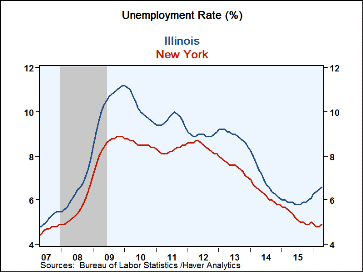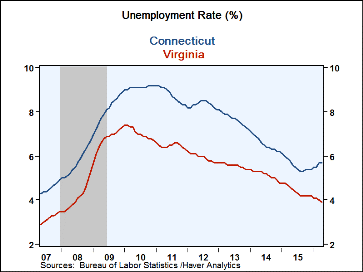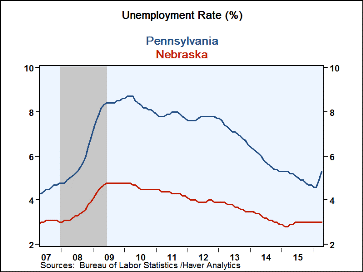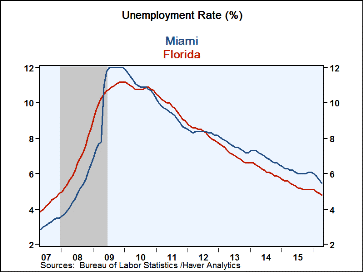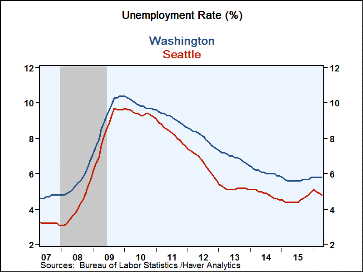 Global| May 23 2016
Global| May 23 2016U.S. State Unemployment Rates Vary Greatly
by:Tom Moeller
|in:Economy in Brief
Summary
The overall U.S. unemployment rate has averaged 5.0% since Q4 of last year, half its late-2009 peak. For all of 2015, the 5.3% jobless rate was down roughly two percentage points from 2014. Despite the overall decline great variation [...]
The overall U.S. unemployment rate has averaged 5.0% since Q4 of last year, half its late-2009 peak. For all of 2015, the 5.3% jobless rate was down roughly two percentage points from 2014. Despite the overall decline great variation amongst individual states continued.
In the latest report for April, California's 5.3% jobless rate was less than half the 12.1% peak averaged during 2010. Unemployment in Illinois of 6.6%, though up of late, was down from the peak of 10.3% averaged both in 2009 and 2010. The jobless rate in Texas has been fairly stable since early last year near 4.5%, but remained down versus the 2008 average high of 8.4%. In Tennessee, last month's 4.3% rate compared to the 2009 average high of 10.6%. New York's unemployment rate of 4.8% compared to the 2009 peak of 8.9%.
Amongst mid-sized states, Michigan showed perhaps the greatest degree of reduced joblessness in the country. It's 4.8% rate was down from 6.4% at the end of 2014, but roughly one-third of its 13.8% peak in 2009. New Jersey's 4.7% rate of joblessness compared to 9.5% averaged in 2010, while Virginia's rate at 3.9% was below the 7.0% peak in 2010. Amongst smaller states, Vermont's decline in the unemployment rate resumed this year and fell to 3.2%, compared to a high of 7.0%. Connecticut's has backed up a bit to 5.7%, yet it's still below the 9.1% for all of 2010. South Dakota's rate fell to 2.5% from the 5.0% peak.
Increased unemployment, however, occurred in several states last month such as Ohio where its 5.2% jobless rate was up from the 4.6% low. Illinois' recent 6.6% rate was higher than 5.8% nine months ago. Pennsylvania's 5.3% jobless rate was up from 4.6% as recently as February. North Dakota's rate of 3.2% was up from the 2.7% low.
The unemployment rate figures in individual metropolitan areas continued, in most circumstances, to differ widely from the state numbers. Florida's 4.8% unemployment rate was below the 5.5% in the Miami metro area, although Miami's rate was down from 11.1% average in 2010. Michigan's 4.8% jobless rate also was under the 5.6% jobless rate around Detroit. In 2009, it averaged 15.0%. New York state's 4.9% unemployment rate was below the 5.4% rate in New York City, while California's 5.3% rate roughly equaled the 5.1% around Los Angeles. Also close to one another were Illinois' unemployment rate of 6.6% and Chicago's 6.5%, both of which have risen lately. Ohio's 5.2% rate equaled Cleveland's rate of joblessness. Working the other way were Washington state's 5.8% jobless rate which exceeded Seattle's 4.8%, which also has moved up.
State unemployment figures are available in Haver's EMPLR database.
| Apr | Mar | 2015 | 2014 | 2013 | Labor Force | |
|---|---|---|---|---|---|---|
|
Total U.S. Unemployment Rate |
5.0% | 5.0% | 5.3 | 6.2 | 7.4% | 157.1 million |
|
Ten States With Highest Jobless Rate |
||||||
| Alaska | 6.6 | 6.6 | 6.5 | 6.9 | 5.9 | 0.4 |
| Mississippi | 6.0 | 6.3 | 6.5 | 7.4 | 8.4 | 1.3 |
| Louisiana | 6.3 | 6.1 | 6.2 | 6.3 | 6.5 | 2.2 |
| Illinois | 6.6 | 6.5 | 5.9 | 7.0 | 8.9 | 6.5 |
| Nevada | 5.8 | 5.8 | 6.7 | 7.9 | 9.5 | 1.4 |
| Georgia | 5.5 | 5.5 | 5.8 | 7.0 | 8.0 | 4.7 |
| North Carolina | 5.4 | 5.5 | 5.7 | 6.2 | 7.8 | 4.8 |
| California | 5.3 | 5.4 | 6.3 | 7.5 | 8.8 | 19.0 |
| New Jersey | 4.7 | 4.4 | 5.6 | 6.7 | 8.1 | 4.5 |
| Tennessee | 4.3 | 4.5 | 5.8 | 6.5 | 7.7 | 3.0 |
| Ten States With Lowest Jobless Rate | ||||||
| Virginia | 3.9 | 4.0 | 4.4 | 5.1 | 5.6 | 4.2 million |
| Iowa | 3.9 | 3.8 | 3.6 | 4.1 | 4.7 | 1.7 |
| Minnesota | 3.8 | 3.8 | 3.6 | 4.1 | 4.8 | 3.0 |
| Utah | 3.7 | 3.5 | 3.5 | 3.8 | 4.5 | 1.5 |
| Maine | 3.4 | 3.4 | 4.4 | 5.6 | 6.6 | 0.7 |
| Hawaii | 3.2 | 3.1 | 3.6 | 4.4 | 4.9 | 0.7 |
| Colorado | 3.1 | 2.9 | 3.8 | 4.9 | 6.7 | 2.8 |
| Nebraska | 3.0 | 3.0 | 2.9 | 3.2 | 3.7 | 1.0 |
| New Hampshire | 2.6 | 2.6 | 3.4 | 4.3 | 5.1 | 0.7 |
| South Dakota | 2.5 | 2.5 | 3.1 | 3.4 | 3.8 | 0.5 |
| Jobless Rate In Other Selected Large States | ||||||
| Louisiana | 6.3 | 6.1 | 6.2 | 6.3 | 6.5 | 2.2 million |
| Washington | 5.8 | 5.8 | 5.7 | 6.1 | 6.9 | 3.5 |
| Connecticut | 5.7 | 5.7 | 5.6 | 6.6 | 7.7 | 1.9 |
| Arizona | 5.5 | 5.4 | 6.1 | 6.7 | 7.5 | 3.0 |
| Ohio | 5.2 | 5.1 | 4.8 | 5.7 | 7.3 | 5.7 |
| New York | 4.9 | 4.8 | 5.3 | 6.3 | 7.5 | 9.6 |
| Michigan | 4.8 | 4.8 | 5.4 | 7.1 | 8.5 | 4.7 |
| Florida | 4.8 | 4.9 | 5.3 | 6.1 | 7.0 | 9.6 |
| Texas | 4.4 | 4.3 | 4.5 | 5.0 | 6.1 | 13.0 |
| Wisconsin | 4.4 | 4.5 | 4.6 | 5.4 | 6.6 | 3.1 |
| Massachusetts | 4.2 | 4.4 | 4.9 | 5.7 | 6.6 | 3.6 |
Tom Moeller
AuthorMore in Author Profile »Prior to joining Haver Analytics in 2000, Mr. Moeller worked as the Economist at Chancellor Capital Management from 1985 to 1999. There, he developed comprehensive economic forecasts and interpreted economic data for equity and fixed income portfolio managers. Also at Chancellor, Mr. Moeller worked as an equity analyst and was responsible for researching and rating companies in the economically sensitive automobile and housing industries for investment in Chancellor’s equity portfolio. Prior to joining Chancellor, Mr. Moeller was an Economist at Citibank from 1979 to 1984. He also analyzed pricing behavior in the metals industry for the Council on Wage and Price Stability in Washington, D.C. In 1999, Mr. Moeller received the award for most accurate forecast from the Forecasters' Club of New York. From 1990 to 1992 he was President of the New York Association for Business Economists. Mr. Moeller earned an M.B.A. in Finance from Fordham University, where he graduated in 1987. He holds a Bachelor of Arts in Economics from George Washington University.


